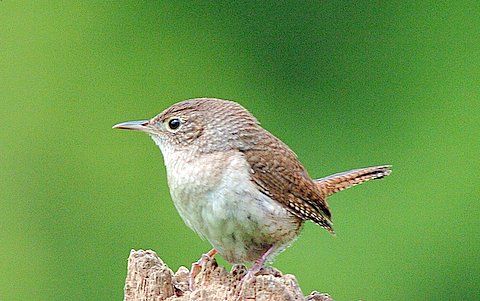– by Mike Azevedo, Fremont, CA…with a trail in Milpitas
House Wrens are native cavity nesting birds. About 98% of their diet consists of insects, including pests like gypsy moths and locusts, with only about 3% of insects consided beneficial (like bees.)
However, They can make themselves a real nuisance, as documented on the webpage on Deterring House Wrens. As mentioned, what to do about them is controversial. Here is another viewpoint.

Around the country, House Wren populations vary from fairly uncommon to…well, let’s just say they’re doing perhaps too well. Wildlife populations go through cycles. At one point, low numbers of House Wrens find plenty of living space, food and nest sites. The rapidly surging population will lead to productive years, lots of baby birds and eventually, a burdensome number of bachelor birds looking for nest sites of their own. Being the aggressive birds they are, if nest sites are few and far between, they will hunt down cavities, nestboxes, etc., farther away from ideal.
They would prefer nestboxes that are closer to thickets and such, but if they have to, they will move further away, taking nestboxes that really should be considered safe for Bluebirds and Tree Swallows, and opening themselves up to predators who find them well away from their safety zone in the thicket.
So what do you do? Do you withhold nestboxes for the House Wrens, figuring there are plenty of House Wrens around and you don’t want to encourage any more of them? If you do, the House Wrens will become even more of a problem to other cavity nesting birds.
I say you provide more housing for the house wrens. Be sure they are houses with smaller entrances or slots that House Wrens would like and most other birds would not. Keep other nestboxes, such as those for Chickadees and Bluebirds, far enough away so that the House Wrens will not fill them up with sticks (called “dummy” nests). Take a look at some of the nestbox guards designed to keep out wrens on boxes close to, but not right next to thickets to prevent their getting filled up with sticks.
Bluebirds are cute and have inspired the movement to help provide nest sites to birds whose habitat has been depleted. All native cavity nesters are in the same boat, however, and deserve the kind of special attention that we give the bluebirds. It may help those birds around the House Wrens to help the wrens with their own plight.
Related webpages:
- House Wren Biology
- House Wren nest photos, including eggs, young and adults
- Other Brown Birds
- Deterring House Wrens
- Links for more information on House Wrens
- video of HOWR removing newborn bluebirds from nest
- Video of HOWR attacking eggs
- Video of House Wren divebombing monitor
These little brown birds … with their constant going and coming with flitting upcocked tails, their innumerable visits to the nest with food to satisfy their clamoring young, their chattering vibrant songs, and their saucy scoldings when I ventured too near….
– A.C. Bent, Life Histories of Familiar North American Birds
